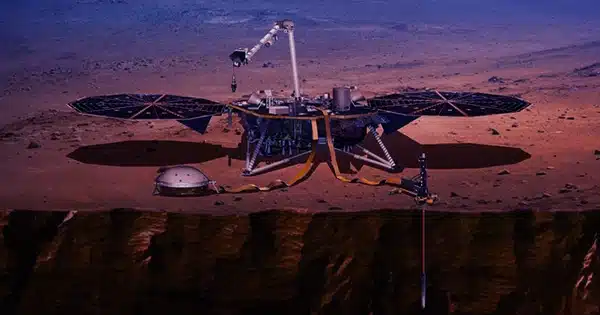NASA’s InSight spacecraft shut down after four years on Mars in December, but its findings will keep scientists busy for a long time. The multipurpose lander investigated marsquakes as well as the Red Planet’s interior features. Scientists discovered that the planet’s rotation rate is growing by 4 milliarcseconds each year.
That means that the Martian day (called a Sol) gets a fraction of a millisecond shorter each year. It is presently 24 hours and 37 minutes long. The Rotation and Interior Structure Experiment, or RISE, was used to obtain the data. This was made up of a radio transponder and antennae that used Deep Space Network (DSN) signals to accurately track Mars’ rotation and how it changes.
“It’s really cool to be able to get this latest measurement – and so precisely,” said Bruce Banerdt, chief investigator for NASA’s Jet Propulsion Laboratory, in a statement. “I’ve been involved in efforts for a long time to get a geophysical station like InSight onto Mars, and results like this make all those decades of work worthwhile.”

The DSN is a network of three massive radio antennas located in the United States, Spain, and Australia that NASA uses to communicate with spacecraft beyond the Moon. NASA would send a signal to InSight, which would be reflected back by RISE. The scientists obtained detailed measurements of Mars’ rotation rate because to tiny changes in frequency caused by the Doppler shift – the same phenomenon that causes an ambulance siren to alter pitch depending on whether it is approaching or going away from us.
“What we’re looking for are variations of a few tens of centimeters over the course of a Martian year,” said Sebastien Le Maistre of the Royal Observatory of Belgium, the paper’s main author and RISE’s primary investigator. “It takes a very long time and a lot of data to accumulate before we can even see these variations.”
The investigation focused on the first 900 days of InSight on Mars. The researchers had to carefully evaluate noise sources such as solar wind and even moisture in the Earth’s atmosphere. The causes of the rotational changes are unknown. Ice distribution changes could be at cause.
“It’s a historic experiment,” Le Maistre stated. “We have spent a significant amount of time and energy preparing for the experiment and anticipating these findings.” Nonetheless, we were astonished along the way – and it’s not finished yet, because RISE still has a lot to reveal about Mars.”
But wait, there’s more: The findings allowed researchers to better predict Mars’ nutation, or how much it wobbles. The cause of this is the planet’s liquid core, the size of which has already been calculated. The radius of the core is estimated to be between 1,790 and 1,850 kilometers (1,112 and 1,150 miles) in the current analysis. The radius of Mars is 3,390 kilometers (2,106 miles). The data also suggests that something strange is going on deep beneath the planet’s surface.
“RISE data show that the shape of the core cannot be explained solely by its rotation,” said the paper’s second author, Attilio Rivoldini of the Royal Observatory of Belgium. “That shape requires regions of slightly higher or lower density buried deep within the mantle.”














